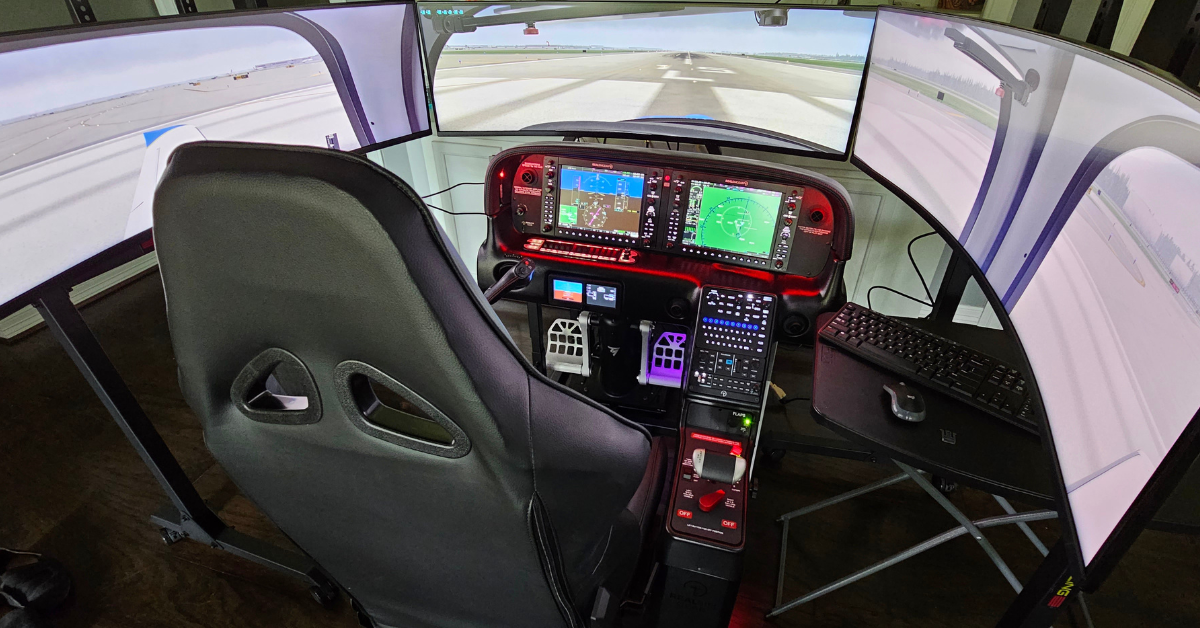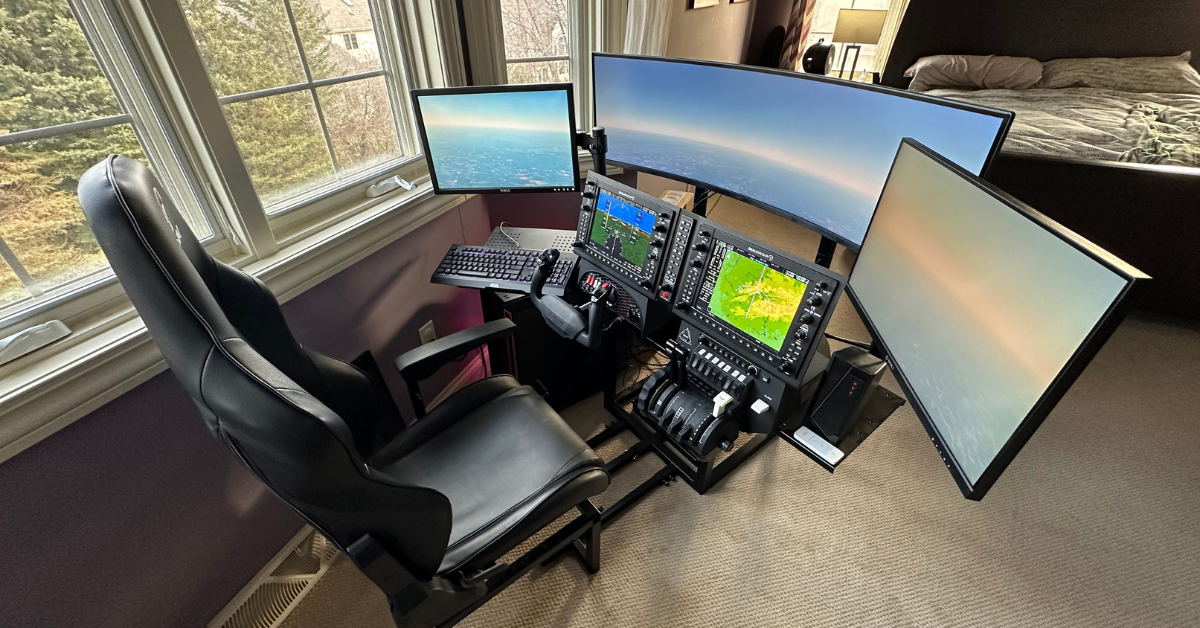Unleashing the Potential of Flight Simulators
How to Use Your Flight Simulator For Training
Flight simulators have come a long way from simple video games for aviation enthusiasts. Today, they are sophisticated, highly detailed tools that serve various purposes for enthusiasts, pilots, flight schools, and airlines. Whether you are a seasoned pilot looking to stay proficient, a student pilot looking to build muscle memory, or a pilot looking to practice emergency scenarios, a home flight simulator can be an invaluable tool. In this blog, we'll explore how you can use a flight simulator to enhance your aviation skills and knowledge.
Keeping Proficient and Building Muscle Memory
Like any other physical skill, flying requires practice to maintain and improve proficiency. One of the primary reasons pilots use flight simulators is to stay proficient and build up muscle memory. With a flight simulator, pilots can practice procedures and techniques in a safe, controlled environment, allowing them to make mistakes and learn from them without risking a real-life emergency.
Take-Offs and Landings
Pilots can improve their abilities in takeoff and landing procedures with a flight simulator by simulating different runway configurations, weather conditions, and equipment failures. This can help them develop the necessary skills and experience to handle these real-life situations.
Simulated takeoff and landing procedures can also help pilots learn how to manage the aircraft's speed, altitude, and approach angles, which are crucial for safe operations. Using a flight simulator, aviators can repeatedly hone their skills in these procedures until they become confident and proficient, improving their overall performance in real-world operations.

Crosswinds: Crosswinds can make takeoffs and landings difficult in single-engine aircraft, as they can cause the plane to drift off the centerline of the runway. Pilots must learn to compensate for crosswinds using appropriate techniques, such as crabbing or slip, to maintain the correct course and avoid a runway excursion.
Short Runways: Short runways can be challenging for single-engine aircraft, requiring pilots to perform a short-field takeoff or landing. This requires precise control of airspeed, altitude, and aircraft configuration, as well as the ability to stop the aircraft within a short distance.
Mountainous Terrain: Landing in mountainous terrain can be incredibly challenging for pilots accustomed to flying in flat land areas. This is because the mountains present a unique set of challenges, such as navigating through narrow valleys and dealing with gusty winds and turbulent conditions. For many pilots, flying in the mountains is a new experience that requires them to learn how to manage the aircraft in such situations and make appropriate decisions to avoid terrain hazards, which can be critical for single-engine aircraft.
Runway Slope: Sloped runways can be challenging for single-engine aircraft, affecting aircraft performance and requiring pilots to adjust their takeoff and landing techniques. Pilots must learn to adapt their speed, pitch attitude, and aircraft configuration to compensate for the slope and maintain safe operations.
Instrument Training
Flight simulators are an excellent tool for instrument training to help pilots learn to navigate and fly using only their instruments. This is an essential skill for pilots who operate in adverse weather conditions or low visibility situations.
IFR Procedures: Pilots can practice instrument flight rules (IFR) procedures in a simulator, such as instrument approaches and departures. This can help them learn the procedures and become more comfortable with IFR flying.
Instrument Navigation: Practicing instrument navigation techniques, such as VOR and GPS navigation, can help pilots learn to navigate effectively using different instruments and become more confident in maintaining the correct course.
Communicating With Air Traffic Control (ATC)
Flight simulators coupled with a service like PilotEdge can simulate realistic Air Traffic Control (ATC) communications, providing pilots with a safe and controlled environment to practice their radio communication skills. This helps them to develop the necessary skills and confidence to effectively communicate with ATC in various scenarios, including congested airspace, inclement weather, and unexpected equipment failures.
Pilots can become more familiar with ATC terminology, procedures, and local communication protocols, and practice remaining calm and focused under pressure; essential for effective communication in real-world operations.
Clearance Delivery: With a flight simulator, pilots can elevate their performance in obtaining clearance from ATC before departure. This involves contacting the clearance delivery controller and obtaining the flight plan, altitude, and route clearance.
Ground Control: Pilots can refine their ground operations, such as taxiing to the runway, requesting clearance for takeoff, and getting directions from ground control.
Tower Control: Rehearsing and enhancing their skills in communicating with the tower controller during takeoff and landing is critical. This includes requesting takeoff clearance, reporting positions, and receiving instructions from the tower controller during landing.
Departure and Arrival Procedures: Pilots can practice following departure procedures, such as SID (standard instrument departure) or ODP (obstacle departure procedure), and communicating with ATC during the departure phase. Pilots can practice following arrival procedures, such as STAR (standard terminal arrival route), and communicating with ATC during the approach and landing phase.
Holding Procedures: Pilots can fine-tune their expertise by entering and holding in a holding pattern as instructed by ATC. This includes communicating with ATC and following the holding procedures.
Scenario Based Training
Flight simulators can simulate scenarios pilots may encounter, such as weather-related issues, traffic congestion, or technical problems. This helps pilots to develop strategies for dealing with these situations and to improve their decision-making skills.

Flying in Different Weather: Flying in severe turbulence can be uncomfortable for passengers and challenging for pilots. Pilots can simulate severe turbulence in a simulator, which can help them learn to handle the aircraft in such conditions and make appropriate decisions.
Airport Familiarization: Pilots can use a simulator to become familiar with the airport layout, taxiways, runways, and parking areas of a new airport. This can help them learn the procedures and operational aspects of the airport before they fly there in real life. Here are nine airports to try landing on a flight simulator.
Terrain Awareness: Practice flying in and out of airports with challenging terrains, such as mountainous or coastal airports. This can help them develop the necessary skills to navigate these airports safely and efficiently.
High-Density Altitude Operations: Flying at high-density altitudes can affect aircraft performance and handling. Pilots can work on their proficiency in high-density altitude operations in a simulator, which can help them learn the effects of density altitude on their aircraft's performance and handling.
Holding Procedures: By using a flight simulator, pilots can program the simulator to simulate a holding pattern and practice the necessary procedures for entering, maintaining, and exiting the pattern.
Practicing Emergency and Uncomfortable Situations
Finally, one of the most significant benefits of flight simulators is the ability to practice emergency and uncomfortable situations that would be too dangerous to perform in a real aircraft. Pilots can simulate various scenarios, such as engine failures, hydraulic failures, fire emergencies, and others. This allows them to develop the skills and knowledge to handle these situations in a real-life emergency. Additionally, flight simulators can be used to practice uncomfortable scenarios, such as instrument failures, night flying, and turbulence.
Engine Failure: Although engine failure is a highly uncommon occurrence, it is still prudent for pilots to simulate such failures in a flight simulator. Pilots can develop the necessary skills and confidence to handle such emergencies effectively by practicing engine failure scenarios in a sim. Moreover, flight simulator training allows pilots to learn from mistakes and refine their responses, which can ultimately contribute to their ability to make quick, informed decisions in real-world operations.
Weather-related issues: Weather-related issues such as severe turbulence, icing, or thunderstorms can pose significant risks to passengers and crew. Purposely flying into bad weather to gain confidence is unwise and not recommended. Pilots can learn to recognize the signs of bad weather, make appropriate decisions to avoid hazardous conditions, and develop the necessary skills and confidence to manage the aircraft in challenging weather situations.
Electrical and Instrument Failures: Electrical and instrument failures can be challenging for pilots, as they may require pilots to fly the aircraft manually without the assistance of instruments. Training and developing capabilities in electrical and instrument failure scenarios in a simulator can help develop the necessary skills to manage these emergencies.
Pitot Tube Icing: A severe problem that can impact the accuracy of airspeed indicators and other instruments that rely on pitot tube data. Although it is rare to encounter such conditions, pilots must build upon their skills and experience in a safe and controlled environment. Rather than risking exposure to pitot tube icing for the first time in an airplane, pilots can use flight simulators to simulate these conditions and learn how to recognize the signs and respond appropriately.

Using a Basic Aviation Training Device (BATD)
With the growing cost of flight training, many pilots are turning to flight simulators as a cost-effective alternative to logging flight time in a real aircraft. In addition to staying proficient, flight simulators can be used as a Basic Aviation Training Device (BATD) to log flight hours and remain current. The FAA recognizes flight simulators as a legitimate training tool and allows pilots to log flight time in a BATD towards their flight review and currency requirements.
